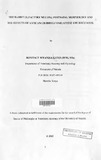| dc.description.abstract | The olfactory mucosa is a chemoreceptor structure located withiJ the vertebrate nasal cavity and functions in detecting and discriminating between odors of different substances. Unlike in most parts of the nervous system where neural formation is confined to intra-uterine life, neurogenesis in the olfactory mucosa is a lifelong process. Rabbits are reputed for their heavy reliance on the olfactory cue owing to their being born blind and deaf and the exceptionally little maternal care that they receive during the suckling period. The preponderant use of this species as a model for toxicological research has also been widely reported. In conventional toxicity studies, substances administered by inhalation have been shown to cause injury to the olfactory mucosa. However, when chemicals are administered systemically, the effort to evaluate the mucosa for lesions has been minimal. Cancer chemotherapy, which is mostly antiproliferative, is associated with various forms of olfactory dysfunction of which the accompanying structural lesions remain largely unknown. In the present work, light and electron microscopy, immunohistochemistry and morphometry were used to analyze the extent and the pattern of structural refinement of the rabbit olfactory mucosa at neonatal
(0-1 days), suckling (2 weeks), weanling (4 weeks) and adult (6-8 months) stages of postnatal development. Further, the impact of anticancer drugs vinblastine and docetaxel on olfactory mucosal structure, and on olfactory function (using the buried food recovery test) were investigated in adult rabbits. In all the postnatal ages, the basic components of the olfactory mucosa were present.
However, Ki-67 immunostaining revealed an age-related decrease in the proliferative rates of cells of the olfactory epithelium. Between birth and adulthood, cross-sectional diameters of axon bundles, packing densities of olfactory cells and cilia numbers per olfactory cell knob increased by 5.5,2.1 and 2.6-fold respectively. Volume fraction for the bundles increased by 5.3% from birth to suckling age and by 7.4% from weaning to adulthood, and the bundle cores were infiltrated with blood capillaries in all age groups except in the adults. Single vinblastine and docetaxel injections to the adults at respective doses of 0.31 and 6.26
mg/kg resulted in marked differences in regard to the degree and duration of lesions that the drugs induced on the olfactory mucosa. On days 3 and 5 in the vinblastine-treated rabbits, there was disarrangement of the normal layering of nuclei of the mucosal epithelia, degeneration of axon bundles, occurrence of blood vessels within the bundles, localized death of cells of Bowman's glands and glandular degeneration.
In the docetaxel-exposed animals, the above changes were evident on postexposure days 5 and 10. Relative to control values, bundle diameters, olfactory cell densities and cilia numbers in vinblastine-treated animals decreased to as low as 54.4%, 75.2% and 70.8%, respectively, on day 5 whereas in the docetaxel-exposed rabbits, the aforementioned parameters were lowest on day 10, with their respective values being 49.3%,63.4% and 50.0%. In the control animals, volume fractions for the bundles and glands were 26.3% and 41.5% respectively. Respective volume fractions for these structures dropped to a low of 16.8% and 38.4% in the vinblastine-treated rabbits at day 5 and 13.4% and 34.9% in the docetaxel-exposed animals at day 10. In contrast, the volume fraction for the blood vessels in the controls was 19.9%, a value which was significantly lower than that of vinblastine-treated animals at day 3 (34.3%) or day 5 (31.5%) and of docetaxel exposed rabbits at day 5 (26.6%) or day 10 (28.5%). Fifteen days after treatment with the two anticancer drugs, all the above changes were resolved' and the mucosa was
morphologically indistinguishable from that of the controls. In the vinblastine-treated rabbits, the buried food test demonstrated a progressive increase in food-finding time in the first three days of exposure (latency score increased from the control value of 44 ᄆ 9 to 179 ᄆ 14 sec on postexposure day 3). On day 5, the animals failed to find the piece of cookie (latency 341 ᄆ 18 sec).
This was followed by recovery from the olfactory deficit with the food-finding time decreasing to 83 ᄆ 12 sec on day 7 and subsequently to 48 ᄆ8 sec on day 15. With docetaxel treatment, the food-finding time increased progressively in the first seven days (reached 169 ᄆ 15 sec on day 7). Inability to find the cookie was
noted on day 10 (latency 329 ᄆ 21 sec), after which recovery from the olfactory deficit was observed by day 15 (latency 115 ᄆ 14 sec). Results of this study show that the structural and functional changes imparted by single parenteral doses of vinblastine or docetaxe1 on the olfactory mucosa are transient and that regenerative recovery, which restores the normal structure of the mucosa and olfactory function, is relatively more delayed during treatment with docetaxel as compared with vinblastine. Further, the progressive modifications in olfactory mucosal structure during postnatal development may be attributed to the high olfactory functional demands documented in this species. While the findings on the normal postnatal morphology of the rabbit olfactory mucosa may form an important basis. for further work involving more ages and species, the data on the impact of the anticancer drugs on the olfactory mucosa may be useful in the design and development of better management strategies for patients with cancer. | en_US |

